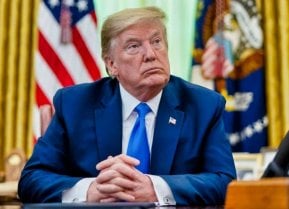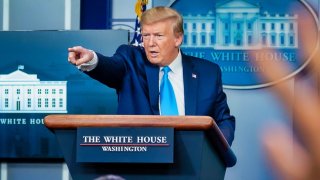Donald Trump: A Threat to the U.S. Economy?
The best economic outcome we can hope for in a second Trump administration is that Mr. Trump will reverse many of the radical economic proposals he made on the campaign trail.
H. L. Mencken, the late American journalist, famously wrote that “Democracy is the theory that the common people know what they want, and deserve to get it good and hard.” Following Donald Trump’s victory in yesterday’s election, the average person will soon learn what Mencken meant. If Mr. Trump implements the economic program that he outlined on the campaign trail, our economy will be in for some very rough sledding over the next four years.
Let’s start with Mr. Trump’s budget policy, which will put our public debt on a truly unsustainable path. If there is one thing Mr. Trump promised on the campaign trail, it was a slew of tax cuts. Among other things, he promised to extend the 2017 Tax Cut and Jobs Act, reduce the corporate tax rate from 21 percent to 15 percent, and eliminate taxes on Social Security benefits. With possible Republican control of both houses of Congress, Mr. Trump will have little difficulty in securing passage of his aggressive tax cut program.
Even before Mr. Trump’s electoral victory, the Congressional Budget Office (CBO) was warning that the country was on a dangerously unsustainable public debt path. On present policies, the budget deficit was expected to remain at around 6 percent of GDP for many years to come. At the same time, by 2034, the public debt to GDP ratio was projected to exceed 120 percent of GDP. That would put our government’s debt at a higher level in relation to income than was the case immediately after the Second World War.
Mr. Trump’s budget proposals would make an already dangerous public debt situation considerably worse. According to the Committee for a Responsible Budget, over the decade ahead, Mr. Trump’s tax cut proposals would add $ 7.75 trillion to the national debt. That would take the public debt-to-GDP ratio to an unprecedented 143 percent by 2035.
One of our economic vulnerabilities is that foreign governments, including the Chinese central bank, own a large part of our debt and help finance our large budget deficits. This raises the real possibility that we could see the return of the bond vigilantes and experience a dollar crisis. Unless we soon correct our profligate ways, at some point, we must expect bondholders to demand higher interest rates on their bond holdings to compensate them for the risk of a renewed inflation surge. Higher interest rates, in turn, would add further pressure to the government’s budget and make our public finances all the more unsustainable.
Another central plank of Mr. Trump’s economic plan would be to resort to import tariffs on a massive scale. He would levy a 60 percent tariff on all imports from China and a 10–20 percent tariff on all imports from the rest of our trade partners. The purported purpose of these tariffs was to bring manufacturing jobs home and to reduce the trade deficit. Never mind that the expected ballooning of the budget deficit would almost certainly result in a widening of our trade deficit. It would do so as a result of our saving level falling even more short of our investment level than it did before.
One of the major drawbacks of massive resort to tariffs is that they will substantially raise import prices. That will hit the common man hard in the pocket and will add to inflation. According to the Peterson Institute of International Economics, Mr. Trump’s tariff proposal will cost a typical US household in the middle-income distribution around $2,600 a year.
Another major drawback of an “America First” program is that it could tip an already weak Chinese and European economy into recession. It could also invite trade policy retaliation by China and Europe in the form of higher tariffs on American imports. That, in turn, could take us down the economically destructive beggar-thy-neighbor policies of the 1930s.
As if all of this were not enough reason for concern about our economic outlook, Mr. Trump has promised to deport up to 11 million undocumented immigrants. If such a program were implemented, it would almost certainly put upward pressure on food prices and cause production disruptions in those industries employing large numbers of immigrant workers.
The best we can hope for economically in a second Trump administration is that Mr. Trump walks back many of the economic proposals he made on the campaign trail. If not, we should brace ourselves for the eventual return of the bond vigilantes, a flight from the US dollar, and some very rough economic sledding ahead.
About the Author: Dr. Desmond Lachman
Desmond Lachman is a Senior Fellow at the American Enterprise Institute and was a deputy director in the International Monetary Fund’s Policy Development and Review Department and the chief emerging-market economic strategist at Salomon Smith Barney.
Image: Creative Commons.


